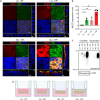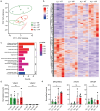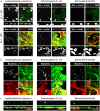Development of a Caco-2-based intestinal mucosal model to study intestinal barrier properties and bacteria-mucus interactions
- PMID: 39714032
- PMCID: PMC11702969
- DOI: 10.1080/19490976.2024.2434685
Development of a Caco-2-based intestinal mucosal model to study intestinal barrier properties and bacteria-mucus interactions
Abstract
The intestinal mucosal barrier is a dynamic system that allows nutrient uptake, stimulates healthy microbe-host interactions, and prevents invasion by pathogens. The mucosa consists of epithelial cells connected by cellular junctions that regulate the passage of nutrients covered by a mucus layer that plays an important role in host-microbiome interactions. Mimicking the intestinal mucosa for in vitro assays, particularly the generation of a mucus layer, has proven to be challenging. The intestinal cell-line Caco-2 is widely used in academic and industrial laboratories due to its capacity to polarize, form an apical brush border, and reproducibly grow into confluent cell layers in different culture systems. However, under normal culture conditions, Caco-2 cultures lack a mucus layer. Here, we demonstrate for the first time that Caco-2 cultures can form a robust mucus layer when cultured under air-liquid interface (ALI) conditions on Transwell inserts with addition of vasointestinal peptide (VIP) in the basolateral compartment. We demonstrate that unique gene clusters are regulated in response to ALI and VIP single stimuli, but the ALI-VIP combination treatment resulted in a significant upregulation of multiple mucin genes and proteins, including secreted MUC2 and transmembrane mucins MUC13 and MUC17. Expression of tight junction proteins was significantly altered in the ALI-VIP condition, leading to increased permeability to small molecules. Commensal Lactiplantibacillus plantarum bacteria closely associated with the Caco-2 mucus layer and differentially colonized the surface of the ALI cultures. Pathogenic Salmonella enterica were capable of invading beyond the mucus layer and brush border. In conclusion, Caco-2 ALI-VIP cultures provide an accessible and straightforward way to culture an in vitro intestinal mucosal model with improved biomimetic features. This novel in vitro intestinal model can facilitate studies into mucus and epithelial barrier functions and in-depth molecular characterization of pathogenic and commensal microbe-mucus interactions.
Keywords: ALI; ETEC; Lactiplantibacillus plantarum; MUC2; Mucus; Salmonella enterica serovar Enteritidis; VIP; air–liquid growth; gut-on-a-chip; intestinal mucosa; tight junctions; transwell.
Conflict of interest statement
No potential conflict of interest was reported by the author(s).
Figures








Similar articles
-
Gastrointestinal cell lines form polarized epithelia with an adherent mucus layer when cultured in semi-wet interfaces with mechanical stimulation.PLoS One. 2013 Jul 15;8(7):e68761. doi: 10.1371/journal.pone.0068761. Print 2013. PLoS One. 2013. PMID: 23869232 Free PMC article.
-
Bifidobacterium dentium Fortifies the Intestinal Mucus Layer via Autophagy and Calcium Signaling Pathways.mBio. 2019 Jun 18;10(3):e01087-19. doi: 10.1128/mBio.01087-19. mBio. 2019. PMID: 31213556 Free PMC article.
-
Development and Functional Properties of Intestinal Mucus Layer in Poultry.Front Immunol. 2021 Oct 4;12:745849. doi: 10.3389/fimmu.2021.745849. eCollection 2021. Front Immunol. 2021. PMID: 34671361 Free PMC article. Review.
-
A mucus layer derived from porcine intestinal organoid air-liquid interface monolayer attenuates swine enteric coronavirus infection by antiviral activity of Muc2.BMC Biol. 2024 Dec 23;22(1):297. doi: 10.1186/s12915-024-02094-7. BMC Biol. 2024. PMID: 39716180 Free PMC article.
-
Home, sweet home: how mucus accommodates our microbiota.FEBS J. 2021 Mar;288(6):1789-1799. doi: 10.1111/febs.15504. Epub 2020 Aug 14. FEBS J. 2021. PMID: 32755014 Free PMC article. Review.
Cited by
-
Probiotic Bifidobacterium bifidum strains desialylate MUC13 and increase intestinal epithelial barrier function.Sci Rep. 2025 Mar 13;15(1):8778. doi: 10.1038/s41598-025-92125-2. Sci Rep. 2025. PMID: 40082523 Free PMC article.
-
Multidrug-Resistant Infections and Metabolic Syndrome: An Overlooked Bidirectional Relationship.Biomedicines. 2025 May 30;13(6):1343. doi: 10.3390/biomedicines13061343. Biomedicines. 2025. PMID: 40564061 Free PMC article. Review.
-
Innovative microfluidic model for investigating the intestinal mucus barrier: numerical and experimental perspectives.Drug Deliv Transl Res. 2025 Oct;15(10):3542-3562. doi: 10.1007/s13346-025-01818-8. Epub 2025 Mar 6. Drug Deliv Transl Res. 2025. PMID: 40048144 Free PMC article.
-
Prolactin promotes transepithelial migration of lymphocytes through CCL2.Poult Sci. 2025 Aug;104(8):105322. doi: 10.1016/j.psj.2025.105322. Epub 2025 May 20. Poult Sci. 2025. PMID: 40446683 Free PMC article.
-
An anaerobic in vitro flow model for studying interactions at the gastrointestinal host-microbe interface.NPJ Biofilms Microbiomes. 2025 Aug 11;11(1):160. doi: 10.1038/s41522-025-00800-z. NPJ Biofilms Microbiomes. 2025. PMID: 40789857 Free PMC article.
References
MeSH terms
Substances
LinkOut - more resources
Full Text Sources
Molecular Biology Databases
Research Materials
Miscellaneous
